Morozov
A.N.
Lecture 5. Where do plants obtain water?
| Knowledge
of some principles easily compensates lack of knowledge of some things. |
| HELVETIA |
Almost
all the plants obtain water by their roots in our arid zone. Sometimes plants
- come from tropical zone, for example maize, grape develops aerial roots, but
less-developed.
Minor part of moisture is absorbed by plant leaves from air,
but only when its humidity is very high and it is close to saturating point (it
takes place only when air temperature is reaching close to so called dew point
- temperature of top-maximal humidity of air when it can contain water in form
of vapor. When air temperature drops lower than dew point temperature then fog
appears or dew is falling).
All roots, either underground or aerial, besides
water supply function they actively take part in creation of organic substances
required for the plants and the process of creation of organic substances in leafage
is completely impossible without such preparation as investigations showed.
Plants roots we may say "go" to deliver water, i.e. are extended at
a growing rate in the direction of zones with available water. There are wild
plants in desert zone roots of which are extended to obtain water to depth down
to 20 meters, for example - alhagi (camel's thorn).
Well-known to anybody
rye has root system of an adult plant with total length of 619 km (kilometers!)
and total surface area of it is 638 m2. Having daily elongation 4,8 km, 100 millions
of root fibrils appear every day. According to some reliable information, its
roots "go to deliver water" to depth down to 2 m and more while basic
mass of fibrous roots is spaced at depth of 1 meter. It is too difficult to realize
this phenomenon, but these are well-tried facts.
Now, in order to understand
clearly how, when and by means of what (with the help of which devices) may we
supply plants with water, we shall tell you about soils properties and its sub-base
like about "a vessel" from where plants obtain water, and more correct
to say - suck out water.
Accepted namatophilous of soil substrates with
various sizes of particles.
Now we shall clarify correct, i.e. understandable
to anybody names of substrates.
In soil science accepted that all sedimentary
rocks where soils are developed shall be divided into the following categories
according to sizes of particles, in mm:
Rocky - of size more than 50;
Semi-gravel - from 2 to 50;
Sandy - from 0,02 to 2,0;
Silty - from 0,002
to 0,02
Clayed - less than 0,002.
But there are no or almost negligibly
sedimentary rocks in nature which consist of particles of the same size. If we
take one kilogram of any soil-forming material, for example loamy soil and try
to sort it out to components according to size of its particles, then it will
be found that even most homogeneous loess-like soils consist of a set of fractions
of different size.
Sorting like that usually is performed in laboratory for
soil investigation. At first, if there are particles of coarse grains in the soil
then screening at separators with holes of different size is performed. If there
are no stones, then screening at separators with holes of size from 0,25 mm to
1,0 mm is performed, and if stones are available, then they add separators of
sizes starting from 3,0 to 50mm and sometimes even 100 mm. Thereat fractions of
size more than size of a separator holes and of holes' size less than has upper
separator are left on each separator.
Each fraction is weighted separately
and its percentage in soil is determined.
Fractions of size less than 0,25
mm are separated in accordance with special method using property of more coarse
particles to be deposited faster than particles of smaller size
Particle
size distribution (more correct will be granulometric composition - weight of
each fraction in percentage terms to soil weight) of soil may be found quick and
precisely enough domiciliary.
Stones, gravel and sand can be easily determined
seemingly and by feel.
Clay like sand can be easily determined seemingly
and especially by feel. Clay - by its plasticity in wet condition, and sand -
by its particles and flowability in dry condition.
It is rather difficult
to determine sandy loam and loam without knowledge of special methods.
The
way to determine soil category according to its granulometric composition with
satisfactory for practice accuracy was shown at Picture 4.1.
Soils were
given with following names depending on proportion of sedimentary rocks particles
of one or another size:
Stony;
Semigravel;
Sandy;
Sandy-loam;
Loamy;
Clayed;
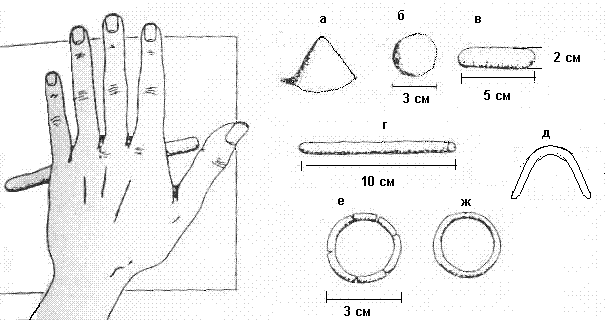
Picture
5.1. Soil features that determine its name according to granulometric composition.
Sandy soils (à) these soils fall to pieces in dry condition suppose
you tried to form a small hump, sandy loams in wet condition can keep hold of
ball shape (b) light loams can be rolled out into shape of small "sausage"
with diameter of 2 cm which is easily crackled. (c) medium textured loams easily
can be distinguished from heavy ones - the "sausages" of diameter less
than 1 cm can not be rolled out from these soils. (d) For heavy loams such "sausage"
easily can be bent into arc without crackling, but are crackled when bend it into
ring shape. (e) For clayed soils, the "sausage" takes shape of ring
without crackling, and even it can be tied in a knot. "Sausage" of length
10 cm and of 1,0…0,5 cm diameter prepared from well wetted soil was shown
at the left.
Aquatic properties of soil substrates depending on particles
size.
A reader may ask a question, what for should he know which particles
form skeleton of soil and what is the name of the soil forming material?
That
is in order to know, that from the particles size and from percentage of one or
another fraction depend many of its properties, which have influence to retention,
movement and accessibility of moisture for plants:
Water holding capacity;
Moisture conductivity;
Thermal conductivity;
Air permeability;
Leaching
from salinity.
Range of moisture accessible for plants;
Problems during
cultivation by machinery at various moisture etc.
Therefore, when we shall
pass on consideration of issues how and which way to irrigate, then we should
learn to speak in language understandable to both of us.
Let us explain by
the examples why listed above properties significantly depend on the particles
size.
Let us imagine small stones in the form of cubes with size of their
edges 1cm. Surface area of each such stone will be 6 cm2, or 600 mm2, and volume
- 1 cm3.
Imagine now, each cube carefully was cut to cubes with size of
its edge equal to 1mm. It means that we shall have 1000 small cubes instead of
the one big cube, and total volume of them will be the same - 1 cm3, but what
is about surface area? Let us try to calculate… Each small cube with edge
size equal to 1mm will have surface area equal to 6 mm2, total number of small
cubes made from 1 cm3 will be 1000, so total surface area of all the small cubes
will be equal to 6 mm2 * 1000 = 6000 mm2, or it is 10 times more than surface
area of the initial big cube.
Hence, if at moistened surface of a stone
with thin layer of water of thickness, say 0,0001 mm may hold without flowing
down, then 0,001 mm * 600 mm2 = 0,06 mm3 will be hold by the big cube without
flowing down, but by small cubes, made from the one big cube, the volume will
be ten times more, or 0,6 mm3 of water will be hold without flowing!
And
if now each cube with edge size of 1 mm to divide into cubes with edge size of
0,1 mm, then unmistakable, that holding capacity will be increased ten times more
and reach 6,0 mm3.
Discussion can be continued with consideration of smaller
particles. Therefore, it is borne in, why having the same volume soil consisted
of small particles hold water better than the soil consisted from particles of
bigger size.
The smaller particles of soil-forming material are the better
such soil holds not only water, but also other matters. This considerably determines
soil absorptive capacity at surface area of particles, i.e. capacity to hold (absorb)
either moisture or salt cations from soil solution.
However, it should be
added that though fine-grained soils (clayed and heavy loam soils) better hold
moisture (adsorb), but they also transfer moisture to plants with great difficulty.
Diagram for easy determination of soil forming material name was shown at Picture
5.2
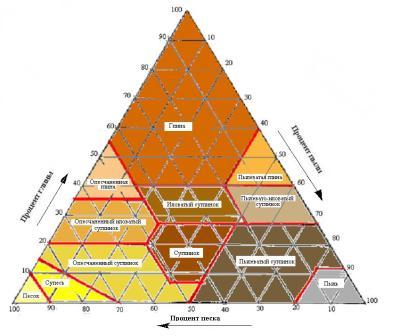
Picher
5.2 Diagram for easy determination of soil forming material name.
To use
this diagram you should find the percentage of clay at left scale and draw horizontal
line from this point in the direction of "% of silt". Then you are to
find % of silt at the right scale and from this point draw line downward in parallel
to diagonal lines of grid lines in the direction of "% of sand" scale.
And finally, after finding the point at the bottom scale related to percentage
of sand then draw line in parallel to grid line upward in the direction of "%
of clay" scale.
Soil substrate name will be at area where all the three
line cross. For example, rock consisting of 20% of clay, 40% of silt and 40% of
sand get to area of Loam.
How water hold in soils?
Let us continue
our discussion on substrate and its "relationship" with soil moisture,
and we shall try to justify, what for we told so much about substrate granulometric
composition. The point is that either total area of particles surface area per
unit weight of soil (usually unit of measurement - square meter per 1 gram is
used in pedology) or pore size between particles of soil depend on their grain
size. And as we told before, from unit area of particles depend amount of adsorbed
moisture, then, from pore size - water and air permeability of soil.
At
Picture 4.3 was shown a bit of soil substrate zoomed very much. Of course, it
is a picture, not microscope, unfortunately it is impossible to install microscope
into soil and prepare a specimen from particles of soil to watch thin water layers
over the particles, it is technically impossible, but on the basis of various
investigations the scientists believe that processes in soil are developed approximately
this way.
Well, let us have a look how water is hold by soil particles.
In big pores of soil with diameter more than 0,7 - 1,0 mm gravity moisture
is placed which can flow down by gravity (1). Capillary moisture is at relatively
far distance from soil particles (2). A layer of lightly bound film moisture is
located just a little closer to soil particles (3).This moisture is well accessible
to plants, it contains soluble salts, but it can freely move only from a particle
to another particle (from thick film moistures loosely coupled with soil to thin
tightly bound ones, i.e. from more waterish places to less humid places.
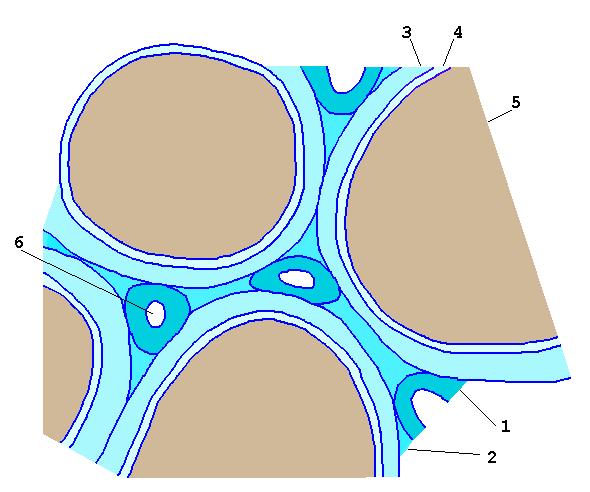
Picture
5.3. Diagram of moisture retention by soil particles (zoomed very much)
-
Free moisture, easily flow down by gravity;
- Capillary moisture;
- Loosely-coupled
film moisture;
- Tightly bound sorbate moisture;
- Mineral particle of
soil;
- "Fixed" air.
Tightly bound sorbate moisture (4) directly
contacts with a particle of soil (5). This moisture is hold so much by intermolecular
forces that it is almost inaccessible to plants because roots can not absorb it.
As scientists suppose, there is no even soluble salts in this moisture. It can
move only when it change to vaporized state.
Bubbles of "fixed"
air (6) possibly are available in coarse spaces between the particles of soil,
i.e. of air, which is difficult to force out during soil saturation (usually full
saturation condition can be reached only in laboratory environment, by moistening
in vacuum condition).
Space fragment between the particles forming basis,
or in other words skeleton of soil you can see at Picture 5.3. Lightly bound moisture
may disappear completely while drying, moisture films may be getting thinner,
down to full disappearance and space between the soil particles will be filled
by air. Meanwhile, most of soil forming materials is settled, i.e. they are compressed
by blocks of different size, and more wide crackles are appeared.
This
skeleton made of particles of soil forming material, wetted and containing air
is "a house" for sorts of soil organisms. Plant roots, mushrooms, microorganisms,
worms, insects, gnawing animals and other visible and invisible living bodies
should live in the "house" to be no more it as soil substrate and to
pass into soil. Activity of most multivarious living bodies, when they dig, drill,
gnaw soil, move and deliver plant residues from surface down to depthward, eat,
digest dead plant roots - they contribute to enrichment of the soil layer by organic
substances and by products of their decomposition, make soil porous, and the most
significant thing - they make it fertile!
The activity of the "population"
of the "house" facilitates to improvement of water properties of soil
forming material. It has impact on that the "population" turn practically
watertight clayed layers turn into well permeable, they stick together sandy soils
to get air renewal, so, generally they adapt that to their needs. All of that
you can read in the most interesting book written by N.I. Kurdumov - "A book
on soil fertility", but now, we shall return again to issue of water supply
for plants.
Water is in soil - try to obtain it!
Amount of retention
force of moisture films of different thickness over soil particles was determined
by investigations. Have a look to diagram shown at Picture 5.4 to imagine more
clearly the amount of retention force of different mentioned above soil moisture
categories by soil particles please, Relative moisture availability in relation
to distances from the layers to soil particle was shown at this picture. The first
layer of moisture that has contact with soil particles is retained by pressure
of 2300 atm.! The fifth layer is retained by pressure of 40 atm. (tightly bound
sorbate moisture), and only after sixth layer (less than 10 atm. - loosely coupled
film moisture) the layers become easily accessible for plants. It was found that
plants are able to suck moisture in by their roots that is retained by soil at
pressures starting from -14…-16 atm.. And when pressure value is more then
the plats perish with "thirst".
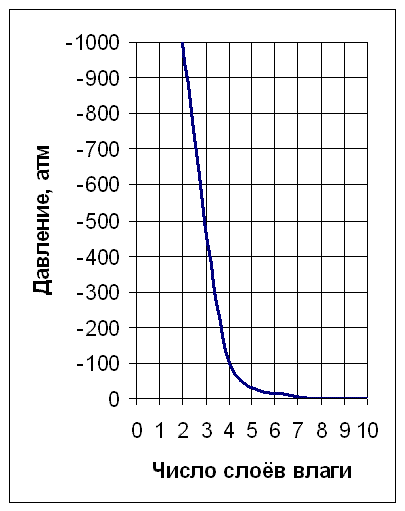
Picture
5.4. Water pressure in the layers that are at different distances from soil substrate
particles.
Let us explain as simple as possible how could it be understood.
Let us imagine, (and it would be better if we take it in our hands) a bit of very
humid soil. Let us try to force out some water from it, for example, wrap it with
a piece of cloth and try to compress it by hands. Possibly you will be able to
obtain some water.
And now, put the bit of soil in compression apparatus
and start gradually to compress it more and more. Then you can see that the less
water is leaving in the soil, the less water is flowing out of it comparatively
to further pressure increasing. You never can not press out moisture to dryness
even as if we tried to increase pressure of our home compressor to maximum of
its capacity. It is explained with that the les water is left in soil then the
thinner moisture films are left around of the particles and the stronger links
they have with the particles. And that is why plants can easily obtain moisture
by their roots when a lot of water is in soil, but when there is shortage of water
it is becoming more and more difficult to obtain moisture.
Before foundation
of values of pressures of different categories of moisture according to its accessibility
to plants, it was accepted in technical literature to specify them by terms shown
at Picture 5.5 and there were also given their numerical values (percentage relatively
to soil volume). We show them to understand what they specified in physical terms.
Values of moisture fractional to soil volume corresponding to one or another
category of moisture according to accessibility to plants for different substrates
are shown at this picture. Let us compare the important "constants"
that determine time of desired ordinary irrigation - MGR - moisture of growth
retardation, which is 5% at sand substrates and reaches 30% at light clayed soils
reaches 30%. Comparison shows that these categories alone can not be interpreted
Now, if we call to memory Pictures 5.3 and 5.4 then it is becoming clear
that not volume content of moisture in root zone (it is better to say in root
attainable zone) is important but its accessibility is important!
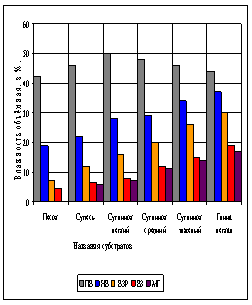
Picture
5.5. Moisture values for different categories of soil moisture in substrates of
various grain-size distribution. Following were specified at the picture:
maximum water holding capacity (MWHC) - soil moisture when all its pores filled
with water;
minimum water capacity (MWC) or field moisture capacity (FMC)
- Moisture that is retained by soil supposedly without flowing off;
moisture
of growth retardation (MGR) (sometimes even more infinite term is used - moisture
of capillaries breaking (MCB):
plants wilting moisture (WM) -lower than this
moisture plants can not recover after irrigation
maximal absorbed moisture
(MAM) - it is defined in standard laboratory conditions at continued humidification
above solution of sulfuric acid because in nature its value is connected with
relative air humidity which is vary continuously.
How does water move through
soil?
As far as investigations of moisture moving through soil developed,
ideas on relationships controlled this process were changing. At the beginning
the investigators thought that moisture movement through soil was like its movement
in capillary pipes of different diameter (Picture 5.6).
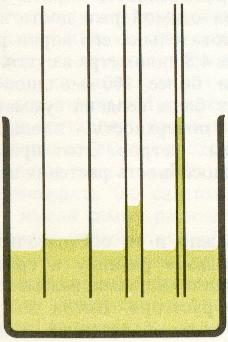
Picture
5.6. Straight capillary pipes in the glass with colored water.
Values of
capillary rise depending on capillary radius were shown in Table 5.1. But real
space between the soil particles hardly looks like capillary pipes, that is why
the scientists in their calculations tried to replace capillary pipes with smooth
surface to pipes with occasionally changed diameter.
Table 5.1. Functional
connection of capillary head from capillary radius.
| Capillary radius, mm. | Capillary head,
m |
| 0.1 |
0.015 |
| 0.01 |
0.150 |
| 0.001 |
1.500 |
| 0.0001 |
15.00 |
| 0.00001 |
150.0 |
Then investigators tried to
describe the space between soil particles as a system of air holes between balls
of the same diameter, but packed in different ways (laid down between them).
Then, admitting the fact that any soil substrate has particles of different diameter,
they tried evaluating the space at different ways of laying down balls of different
diameter.
Finally, the investigators came to a conclusion that as substrate
particles forming soil are different not only by diameter and shape but also depending
on minerals composited soil substrate - of solid natural or artificial bodies
that have one or another chemical or physical properties, and as well as bioorganic
activity of the "population" of the soil impacts very much to them,
they decided to determine some average properties that are necessary for practical
activities. Well-known scientists-engineers did much for understanding of water
movement rules through soil substrates. Anri Darcy, engineer from France, found
law of water flow through waterlogged substrates. Blez Pascal determined number
of laws of hydraulic that explain many phenomena of moisture movement through
soil, main from them is U-tube law.
But… the soil where live a lot of
all kinds creatures is continuously changed under impact of their activity. But
we are to say, that the soil substrates themselves where soils are developed,
especially clayed and loamy one are changing their water permeability (soil solutions)
either depending on degree of saturation with water (and that also means with
air)and of availability of dissolved soils in it - in million and more times (it
is too difficult to imagine, but it is so!). It is connected either with soil
minerals rebound or changing of their permeability after having contact with salts
ions that are presented in the soil solution.
It is so interesting and incomprehensible
theme to describe in brief in the last everything that is happening under our
feet in the soils.
Therefore we shall simply outline in brief - under which
pressure of forces soil solutions move and that is in order to be clear for you
when we start the issue on plants watering.
So, the main force, thanks
to which many processes take place on earth, and which was a reason for falling
down of an apple that hit Isaac Newton's head and which made him think on the
law of gravitation - it is force of gravity.
The whole free moisture (as
we told above, so not tied with soil particles) moves under influence of this
force.
Incoherently water moves in capillary under surface tension forces,
but tightly bound moisture flows (crawls) from thick films to thin one, and it
almost makes no difference for such categories of moisture because of its relative
smallness. The most tightly bound moisture is practically motionless and it can
move only after getting vaporized state.

